Places: The People of Israel and Palestine
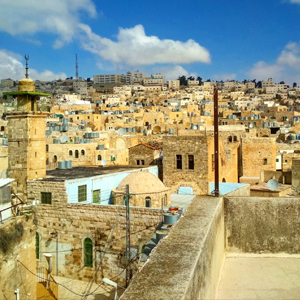
Of late, terrorism, atrocities, and the killing of thousands of innocent civilians are all that we have heard about from this region. During my visit here in 2018, I observed people on both sides to be earnest in their quest to coexist despite the status quo of mistrust and hate that seems to dominate in some (mostly official) circles.
[Top] Jerusalem, the Holy City, has been under the rule of the State of Israel since 1967. (All photos by V. Ramana Dhara MD)
In January 2018, prompted by my nephew’s invitation, I joined him on a trip to Israel and Palestine. He had planned on visiting universities there with the intent of academic collaboration. Landing at the Tel Aviv airport, the immigration officer inquired about the purpose of my visit, as I was not with one of the many religious tour groups that regularly come there. When I informed him that I was just a tourist, he appeared somewhat doubtful but let me through, possibly because of my U.S. passport. In contrast, my nephew, who held an Indian passport, had difficulty obtaining an Israeli visa and was questioned repeatedly about the reason for his visit. The impression we got was that non-religious tourism gets more scrutiny, perhaps due to the ongoing social and political issues in the region.
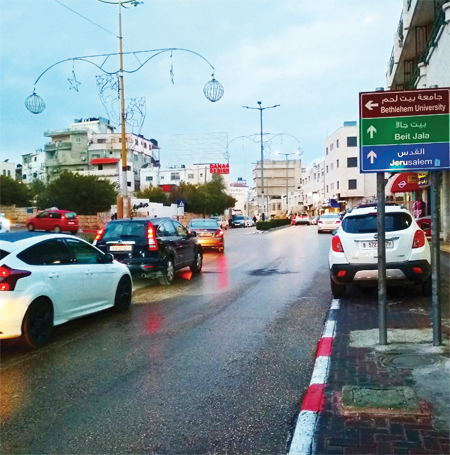 Israel: A history and culture of pluralism
Israel: A history and culture of pluralism
We took the airport shuttle to Jerusalem, the Holy City, which is a hallowed land for the three Abrahamic religions: Islam, Judaism, and Christianity. Christ was born a stone’s throw away in Bethlehem and is believed to have ascended to heaven in Jerusalem. Curiously, the Chapel of the Ascension had a Muslim caretaker at the time of our visit. While we could see the Wailing Wall where Orthodox Jews pray, the Al-Aqsa Mosque was not open to non-Muslims.
[Right] A street scene in Bethlehem, located in the West Bank, Palestine.
The pervasive presence of Israeli police all throughout the city indicated that religious tension could erupt at any time. However, walking the streets of Jerusalem at night, we experienced none of the unsafe conditions present in some American cities. Both Israel and the West Bank in Palestine are relatively safe for women. We saw young women in Israel hitchhiking alone, as well as Arab women walking alone in the streets of Ramallah, even late at night.
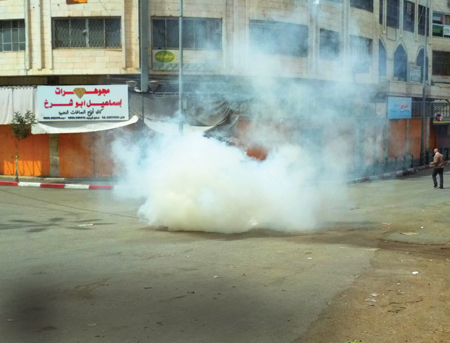
[Left] The Israeli occupation of Bethlehem and the rest of the West Bank is often a source of conflict. The author and his nephew came upon one such incident when tear gas was deployed.
We experienced Israel as an open, modern, and democratic nation with impressive strides in the sciences and a healthy allowance of free expression. People protest vigorously for various causes, as they are now doing against the proposed limitations on the Supreme Court, and for cease-fire and hostage release. We witnessed high schoolers in Jerusalem peacefully protesting against mandatory service in the Israeli military, even though their opponents jeered them in their faces. In Jerusalem, we met with an Israeli 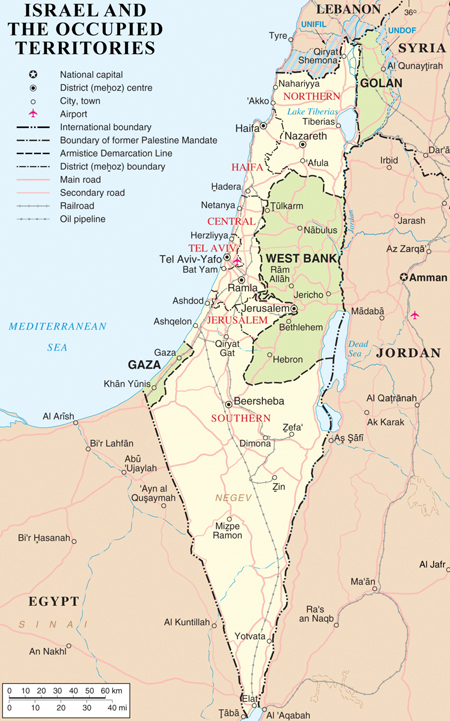 American Jewish professor, Jeff Halper, of the Israeli Committee Against Home Demolitions. Halper was nominated for the Nobel Peace Prize for chaining himself to Palestinian homes to prevent them from being bulldozed.
American Jewish professor, Jeff Halper, of the Israeli Committee Against Home Demolitions. Halper was nominated for the Nobel Peace Prize for chaining himself to Palestinian homes to prevent them from being bulldozed.
The Reform Jews and the Orthodox Jews poke fun at each other. One of our hosts said he gets a better deal on a rental car if he waits for the Orthodox “fundos” to snap up the cheap ones! The ultra-Orthodox consider Tel Aviv to be ultra-liberal on social issues. Both Reform and Orthodox Jews have a range of views on Zionism (a national movement for the return of Jewish people to their homeland), and not all members of either group are Zionists. While there, we heard that some of the older ultra-Orthodox Jews consider their government to be Zionist and needlessly militarized.
To our surprise, we came to realize that twenty percent of the Israeli population is Arab, comprising of Muslim, Christian, and Druze ethnicities—all of whom are represented in Israeli political life. Indian-origin Jews include the Bene Israel (many of whom were active in the Indian film industry), the Cochin Jews, the Baghdadi Jews, and the B’nei Menashe from northeast India. Perhaps we were mistaken for Bene Israel by a Jerusalem resident who asked us rather curtly to “speak Hebrew!” Many Indian workers are also reported to be replacing Palestinian construction workers, particularly since the recent Israel-Hamas war. Indian tech workers are also increasingly seen here.
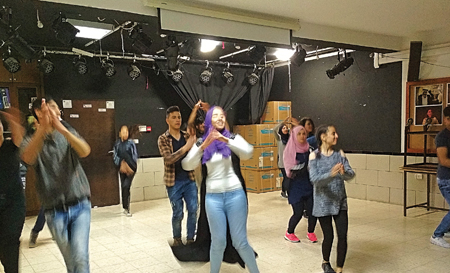
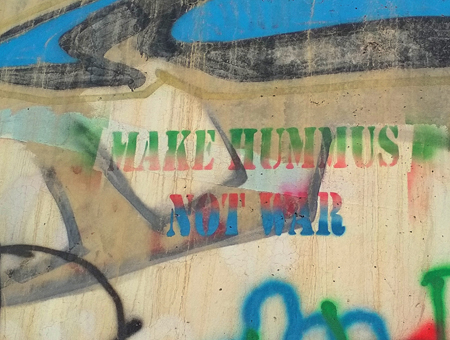
[Left] A rehearsal of a performance at the Freedom Theater in Jenin, a city in the West Bank.
Palestine: Aspirational and heartwarming despite being subject to oppression
Entering the West Bank, we saw prominent Israeli government signs warning of danger in these areas; but again, in the weeks we spent there, we did not experience any danger—save one incident in Bethlehem where we were walking down a road and smelled tear gas. A Palestinian youth had donned a gas mask and was walking defiantly toward an Israeli guard tower from where the tear gas had been fired. Motorists cautioned us not to proceed further and we saw some of the foreign press photographing tear gas shells.
[Right] “Make Hummus, Not War,” implores a work of graffiti in the region.
What we saw more often was the interrogation of Palestinians at border crossings where they could spend hours in sudden and unexplained closings. Some Israeli soldiers, who had experienced regret at performing this kind of inhumane enforcement, after leaving the military, have formed an organization called Breaking the Silence, which organizes tours to the West Bank to provide an alternative perspective on the Occupied Territories.
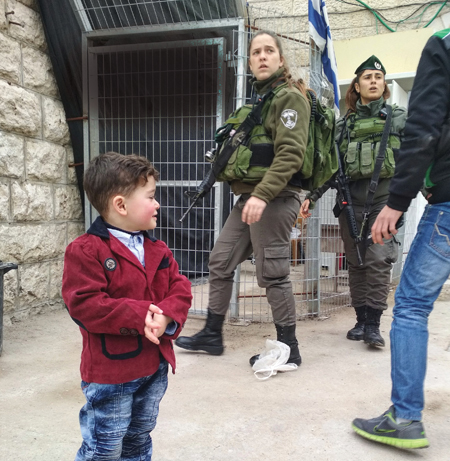 The West Bank Palestinians, under Israeli occupation, talked about their experience of travel restrictions and a sense of being under siege. Palestinian Americans, for example, aren't allowed through Tel Aviv, and so they fly into Jordan to come to Palestine. Even within the region, Palestinians weren’t allowed to cross the border to visit their places of worship in Jerusalem.
The West Bank Palestinians, under Israeli occupation, talked about their experience of travel restrictions and a sense of being under siege. Palestinian Americans, for example, aren't allowed through Tel Aviv, and so they fly into Jordan to come to Palestine. Even within the region, Palestinians weren’t allowed to cross the border to visit their places of worship in Jerusalem.
Despite the hardships, like people everywhere, we found Palestinians to be aspirational—women’s enrollment in universities is over 60 percent, as parents see value in daughters being educated. Unemployment, however, continues to be widespread. One resident of Jenin, a city in the Israeli-occupied West Bank, told us he would like to see his children study and work in Israel.
[Left] A Palestinian boy and Israeli soldiers at the Hebron refugee camp.
The hospitality and bonhomie of Palestinians, even under occupation, were heartwarming. Burqa-clad women would go out of their way to walk or drive us to our destinations in West Bank towns. In Ramallah, we were pleasantly surprised to find ourselves serenaded with Bollywood songs by Arabs in the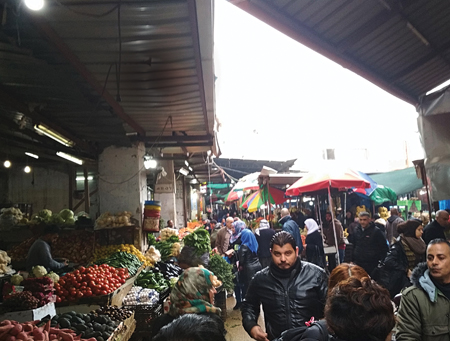 street. I provided medical aid to our Airbnb host in Ramallah and was rewarded with ayran (or doogh), a delicious spicy yogurt drink, and a trip to their olive orchard in Jericho, one of the oldest living cities in the world.
street. I provided medical aid to our Airbnb host in Ramallah and was rewarded with ayran (or doogh), a delicious spicy yogurt drink, and a trip to their olive orchard in Jericho, one of the oldest living cities in the world.
Israelis and Palestinians have many cultural similarities and inhabit a beautiful country, but their differences run deep, and the scars of conflict make cohabitation seem insurmountable. As I left the country, I recalled Jimmy Carter’s courage in questioning the displacement of Palestinians from their territories and asked myself what I would do if outsiders similarly occupied my home.
[Right] A normal day at a market in Jenin.
V. Ramana Dhara, MD is a former Georgian, now living in Pennsylvania. You can read a photojournalistic essay that grew out of this trip, written by his nephew, at: https://www.firstpost.com/tag/palestine-in-photos.
Enjoyed reading Khabar magazine? Subscribe to Khabar and get a full digital copy of this Indian-American community magazine.
blog comments powered by Disqus












